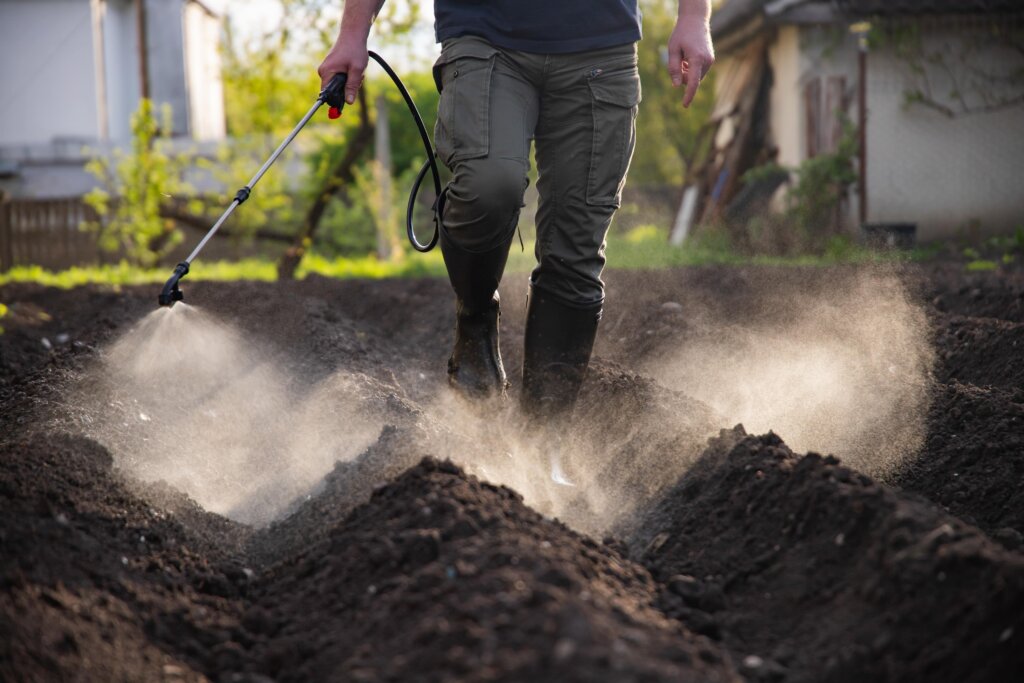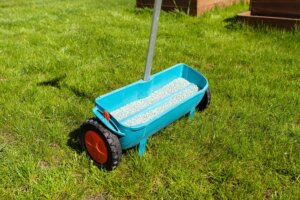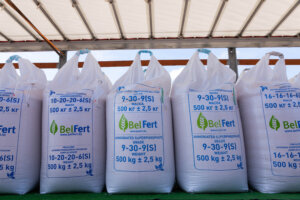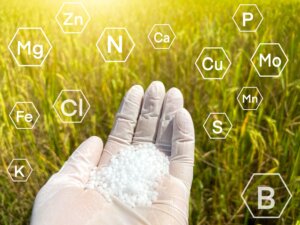Want that vibrant, golf-course green lawn—fast? This guide to fast-release fertilizer reveals how to achieve quick, healthy growth and transform your yard into the lush turf your neighbors will envy.
Key Takeaways
- Quick Action: Fast-release fertilizer delivers nutrients instantly after watering for visible results in 3–7 days.
- Nutrient Boost: Provides nitrogen, phosphorus, and potassium to improve grass growth and color.
- Best Timing: Apply in spring or early fall when turf is actively growing.
- Application Tip: Use 1 lb. of nitrogen per 1,000 sq. ft., water afterward, and apply in cooler hours to avoid burn.
- Duration: Feeds lawns for 2–4 weeks compared to 6–12 weeks for slow-release fertilizers.
- Pro Tip: Alternate with slow-release nitrogen fertilizer or get expert help from Terra Lawn Care for balanced results.
What Is a Fast-Release Fertilizer?
A fast-release fertilizer—sometimes called a quick-release fertilizer—is formulated to deliver nutrients immediately upon watering. Unlike slow-release formulas that feed over time, these fertilizers dissolve quickly, providing your grass with nitrogen, phosphorus, and potassium right when it needs them most.
They’re ideal for homeowners seeking quick results, especially when dealing with pale or patchy turf, new seedlings, or areas needing fast recovery. Within just a few days, you’ll often notice greener coloring and improved grass growth.
If you’re unsure which fertilizer type best suits your lawn’s specific needs, our guide on Choosing Lawn Fertilizer: How to Select the Best for Your Lawn offers a clear comparison of nutrient blends, release rates, and lawn conditions.
How Does Fast-Release Fertilizer Work?

Fast-release fertilizers are typically water-soluble, meaning the nutrients dissolve rapidly into the soil after watering or rainfall. Once absorbed, nitrogen fuels leaf and plant growth, while phosphorus and potassium strengthen root growth and resilience.
Because of this fast-acting nature, these fertilizers are great for:
- New lawns that need a nutrient boost to establish roots.
- Small patches or damaged spots that need recovery.
- Early spring or late summer applications to kickstart growth.
However, timing is key. Apply in the early evening or late afternoon when temperatures are cooler to prevent evaporation and fertilizer burn.
For consistent, professional results, many Pennsylvania homeowners rely on expert fertilization programs like Terra Lawn Care’s Lawn Fertilization Service, which ensures the right nutrient balance for every grass type and soil condition.
Fast Release vs. Slow Release Fertilizers
| Feature | Fast Release Fertilizer | Slow-Release Fertilizer |
|---|---|---|
| Nutrient Delivery | Immediate | Gradual, steady pace |
| Best For | Quick green-up, new lawns | Consistent growth, maintenance |
| Risk | Fertilizer burn, frequent mowing | Minimal burn, lower maintenance |
| Duration | 2–4 weeks | 6–12 weeks |
| Typical Form | Water-soluble or liquid form | Granular fertilizers |
While fast-release fertilizers provide a quick nutrient boost, slow-release fertilizers or slow-release nitrogen fertilizers feed lawns at a steadier pace. For example, a slow-release fertilizer is perfect for maintaining an already dense, attractive lawn, reducing the risk of too much growth or frequent mowing.
To explore in-depth comparisons, see our guide on Slow-Release Fertilizers.
When to Apply Fast-Release Fertilizer for Best Results
Timing matters when applying fast-release fertilizers. In Pennsylvania’s climate, the best periods are spring and early fall, when your turf—especially Kentucky bluegrass or cool-season grasses—is actively growing.
Avoid applying during hot summer afternoons to reduce the risk of fertilizer burn. Instead, apply in the early evening, after a light watering or rainfall. Use a mechanical spreader or garden hose sprayer for even coverage.
If you’re unsure how much to apply, consider consulting local experts like Terra Lawn Care. Our certified agronomists and technicians have decades of experience optimizing soil health and plant growth in the Tri-State area.
How to Apply Fast-Release Fertilizer

To ensure even nutrient distribution and avoid over-fertilization, follow these steps:
- Test Your Soil: Identify nutrient deficiencies before application.
- Measure Lawn Area: Apply one pound of nitrogen per 1,000 sq. ft. for balance.
- Spread evenly: Use a spreader for granular fertilizers or a sprayer for liquid form.
- Water After Application: Helps nutrients penetrate the soil and reduces burn risk.
- Mow After a Few Days: Once grass growth increases and color improves.
For a complete understanding of fertilizer types, visit Types of Fertilizers: The Complete Guide to Lawn and Garden Nutrition.
Benefits of Using Fast-Release Fertilizers
- Immediate Green-Up: Enhances green coloring within days. For example, according to the University of Nebraska–Lincoln Turf Fact Sheet, quick-release (soluble) nitrogen sources can cause a response in one week or less, while slow-release sources take three to ten weeks.
- Encourages Root Growth: Nitrogen promotes both shoot and root development.
- Ideal for Repairs: Perfect for new seedlings or nutrient-deficient lawns.
- Supports Soil Health: Quick nutrient availability helps balance poor soil conditions.
However, frequent use can lead to fertilizer burn or excessive top growth. Alternate with slow-release formulas to maintain a healthy, lush lawn all season long.
Local Expertise: Terra Lawn Care in Pennsylvania
As a family-owned business serving the Tri-State area since 2003, Terra Lawn Care provides high-quality lawn care overseen by a professional agronomist. With over 50 years of combined experience, their PA-certified technicians help homeowners achieve the nicest lawns on the block, from custom fertilizer programs to long-term turf management.
A Smarter Way to Feed Your Lawn
A fast-release fertilizer is a powerful tool for homeowners who want quick results—especially during active growing seasons like spring and fall. When used strategically, it can transform dull or nutrient-deficient turf into a vibrant, lush lawn.
For personalized lawn care advice or to schedule a visit, contact us today.
Frequently Asked Questions About Fast-Release Fertilizer
Fast-release fertilizers usually contain water-soluble nitrogen sources such as ammonium nitrate or urea. These nutrients dissolve rapidly, making them ideal lawn food for quick grass growth.
Unlike slow-release fertilizers, which feed plants gradually, fast-release options provide an instant boost to help grass types recover after stress or damage.
Most fast-release fertilizers begin showing results within 3 to 7 days, depending on rain, watering, and soil conditions. This quick action supports visible green-up and stronger plant development. For best results, follow the label instructions and alternate with slow-release nitrogen fertilizer to maintain steady nutrient levels.
Not necessarily. The “10-10-10” number represents the major components—nitrogen (N), phosphorus (P), and potassium (K)—but doesn’t specify how quickly nutrients are released. Some 10-10-10 products are slow-release, while others are fast-acting, so always read the packaging carefully before you purchase.
Check the label for terms like “water soluble,” “fast acting,” or “quick release.” These fertilizers typically dissolve in water or activate when you spray or water the lawn. In contrast, slow-release fertilizers release other nutrients gradually, helping maintain long-term health for different grass types.
Yes, combining both can be beneficial. Fast-release products deliver immediate nutrients, while slow-release fertilizers sustain feeding over several weeks. This blend gives your plant both instant energy and lasting nutrition, ensuring steady grass growth and healthier soil balance.



